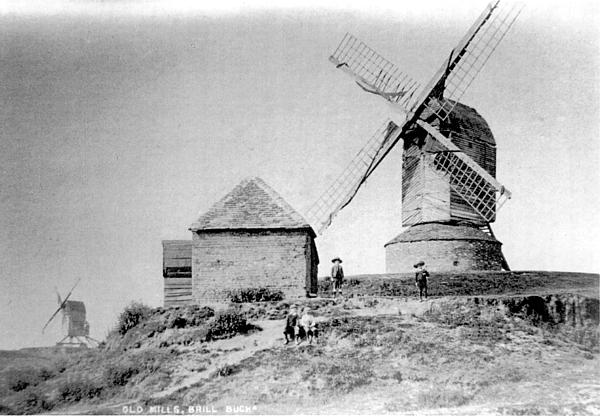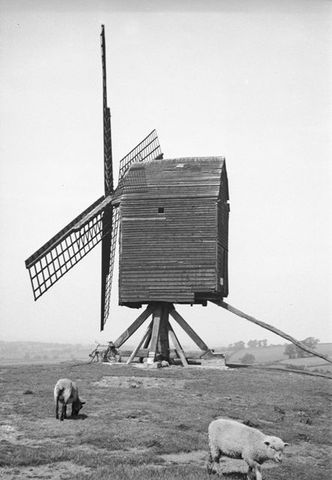|
. . . . AND THOSE AROUND TRING
CHAPTER XII.
BRILL POST
MILL |

Fig. 12.1: Brill post mill
|
The old post mill at Brill stands on the ‘Common’, a promontory commanding the most magnificent view of the Vale of Aylesbury.
When taken
together with a look around the charming village of Brill, these are added
incentives to visit this particular windmill.
“There appears to have been a rectory manor
of Brill, the rector holding assize of bread and ale for his tenants
in 1276. The manor had a mill in 1086. Two centuries
later a windmill was built here of timber from Bernwood Forest,
probably on the site on which John de Moleyns, about 1345,
constructed another with oaks felled in his demesne woods.
From that time until 1733 a windmill appears amongst the
appurtenances of the manor, of which the ancient windmill now
standing may be the survival.”
Victoria County History — A
History of the County of Buckingham: Volume 4.
The earliest of the mills to which this extract refers were
either watermills or mills driven by animals. By 1345, the
windmill had arrived in Britain and that “built here of timber
from Bernwood Forest” [17] was
probably the beginning of a legacy of wind milling at Brill that
lasted until 1924, when the post mill that stands today closed for
business.
Judging by the partly obliterated inscription R.C.E. -68-I.C.
carved into a beam on its meal floor, Brill post mill was
erected by the millwright Rex Carolus for I.C. (possibly Isaac
Cummings) during the 1680s:
“Background
research and building recording carried out in May and June 2006 by
Bonwick Milling Heritage Consultancy. Dendro-dating obtains a
felling date of winter1685/6 for timber from the breast beam,
suggesting that construction of the mill took place in 1686, with 2
subsequent datable phases of repairs and alterations. Building
recording suggests a total of 4 phases of repairs: about 1725 when
mill was substantially rebuilt, 1757 when mill was again
substantially rebuilt [18],
1760 or later and in the mid-19th century.”
Buckinghamshire County Council.

Fig. 12.2: another post-mill
once stood on Brill Common. Built in 1634 and latterly known
as Parson’s Mill, it stood on the opposite side of the road to the
mill that stands today; in the photograph above it can be seen in
the background. Parson’s Mill was struck by lightning in 1905
and demolished in the following year. The mound (‘tump’) on
which it stood is still clearly visible. Brill post mill
received its roundhouse in 1865. In poor condition, it was
removed in the 1930s, rebuilt in 1950 and again in 2009.
The last of what must have been a long line of millers was Albert Nixey,
who took over in 1911 and used it to mill wheat until 1919,
although it is believed that he continued to mill barley for animal
feed for a further five years. Mr. Nixey described his mill in
the following terms:
“The centre-post is square at the base with
chamfered corners, and measures 9 feet round its sides; higher up it
is rounded and 5½ feet in circumference, diminishing to 4½ feet
above. The bottom part of the post used to be open to the
Common; a wall was built round it and roofed in 1864. |
|
 |
 |
|
Fig. 12.3: “the
centre-post is square at the base with chamfered corners.” |
Fig. 12.4: “higher up it is
rounded and 5½ feet in circumference, diminishing to 4½ feet above.” |
|
The bottom floor of the mill itself (16 feet by 9 feet 3 inches)
contains the bin into which the flour runs, and a recently-placed
oat-crusher. To make way for the band which drives the
last-named machine, the ‘16,’ of the date ‘1668,’
boldly carved on at tie-beam which supports
the upper floor, has been barbarously cut away. On the floor
above are the stones, one pair of burrs for wheat, and one of Peak
stones for barley. There is also on this floor a
wheat-dressing machine of a modern kind; a slanting box has a wire
screen throughout its length; inside this a spindle carrying brushes
revolves rapidly and brushes the fine flour through first, then the
toppings, and lastly the bran. |

Fig. 12.5: brake wheel,
wallower and millstones. On top of the left hand stone case is
the hopper, containing grain
which flows down the shoe into the eye of the stones to be ground.
The bell alerts the miller when the hopper runs low.

Fig. 12.6: interior of the
mills wheat dressing machine. It is missing its screens (for
explanation, see fig. 13.3)
|
The sails are of the old type with
sail-cloths, which are set by fastening one end to the extremity of
the sail and unrolling it from the ground; the sails are each 27
feet long and 5 feet wide, and in at good wind they will grind one
sack of barley in an hour with one pair of stones. In this, as
in all wind-mills, the main driving wheel is keyed to the sail-beam;
the outer rim of this great wooden wheel is acted upon by a curved
piece of iron in the manner of a hand-brake. By releasing the levers
which control this brake the mill is started.”
From In Buckinghamshire, by G. Elland
(1923) |

Fig. 12.7:
massive oak
windshaft, wooden brake wheel and wallower (for explanation, see
fig. 3.8)
|
|
 |
|
Fig. 12.8: Brill
post mill in the 1930s. |
In 1928, the mill, by then in a poor state of repair, was offered
for sale . . . .
|
“. . . . and was bought by Major H.
L. Aubrey-Fletcher, the present lord of the manor, and has been
handed over to Trustees . . . . Sufficient funds were raised by
public subscription for the mill to be put in good order.
Funds are now required for a sufficient endowment to cover the small
cost of upkeep. The fee charged for viewing the interior of
the mill, together with the proceeds of the sale of s descriptive
leaflet, are devoted to the purpose. The brick roundhouse that
stood when the mill was surveyed by the Royal Commission on
Historical Monuments has been removed since then. The post has
been strengthened and rendered secure, and the ladder has been
removed, otherwise the mill is unchanged, and presents an excellent
example of mediæval mill economy. The four sails carried
canvas cloths which were furled from the ground according to the
strength of the wind.”
English Windmills, Vol. 2, by
Donald Smith (1932) |
As anyone who lives in an old mill soon discovers, the cost of its
upkeep is by no means trivial and requires a deep pocket:
“Brill’s Famous Windmill — A 17th century
windmill at Brill, one of Buckinghamshire’s historic landmarks, is
to be taken over by Bucks County Council, who will be responsible
for its future repair, maintenance and management. The mill is
included in the inventory of historical monuments in
Buckinghamshire, which the Royal Commission on Historical Monuments
selected as especially worthy for preservation. In 1929
Alderman Sir Henry Aubrey-Fletcher bought the windmill to save it
from destruction, and since then it has been maintained by trustees.
The only fund available to the trustees has been interest on £70
invested in railway stock and the infrequent sixpences of visitors
to the mill. Mr. Rex Wailes, an expert on windmills, has
advised that it will not be possible to save the mill much longer on
the present funds, and in view of this the County Planning
Committee, satisfied that it would be desirable to preserve the
mill, recommended Bucks County Council, meeting in Aylesbury
yesterday, to accept voluntary conveyance of the windmill together
with the invested funds of £70, and to undertake its future repair,
maintenance and management.”
The Bucks Free Press, 28th
February 1947
Windmills are particularly vulnerable to the ravishes of the
weather, and a mill of all-wooden construction particularly so.
By 1947, Bill windmill was again in need of urgent attention when a
storm took off one of its sails — which in turn split the
brake-wheel — and damaged the outer fabric of the mill, while
other repairs were needed to the mill’s machinery and internal
structure which in places had fallen victim to woodworm. The
work was carried out by a team led by the windmill author Stanley
Freece. [19] Probably the most evident external feature to
come out of this work was the restoration of the roundhouse, the
original having been taken down when repairs made in the 1930s.
In the immediate post-war years, when building materials were in
short supply, Freece was fortunate not only in obtaining the
services of a retired bricklayer to carry out much of the work, but
being given
gratis the necessary bricks from a kiln that had been
demolished when the last of Brill’s many brick and tile yards
closed. Others also contributed to the restoration. The
new roundhouse was completed in 1950 and, according to Freece, the
restoration of the mill’s interior was completed with a liberal dose
with creosote.
In 1967 the Council installed a structural steel framework to help
support the mill’s ancient timber frame, but as a result it
can no longer be revolved on its post to face the wind. |
 |
 |
|
Fig. 12.9: Brill post mill,
showing the new roundhouse
and the tail pole, used to
wind the mill |
Fig. 12.10: the roundhouse roof is tiled with cedar
shingles
set on sarking boards |
|
By the turn of the Millenium,
leakage and weathering was causing timber decay, to the extent that
the structural integrity of the Grade-II listed mill was placed “At
risk”. The Brill Windmill Management Group was established in
2007 to help plan a restoration project and to seek the necessary
funds. With funding of £280,000 from English Heritage and
Waste Recycling Environmental Limited, full repair could go ahead.
Work commenced in 2008, during which the need to remove the trestle
timbers required holes to be cut through the roundhouse walls.
This revealed that the bricks and mortar used in the 1950 rebuild
were of poor quality — in fact, the surface of some of the external
brickwork was flaking. The roundhouse could not therefore be
dismantled and its bricks recycled, and a new roundhouse had to be
built.
Preservation work was completed by July 2009. The mill is now
structurally sound and is again open to the public.

Fig. 12.11: the
Millenium Window depicting the mill in stained glass.
Stewart Bowman (1999), All Saints Church, Brill |
――――♦――――
CHAPTER XIII.
|